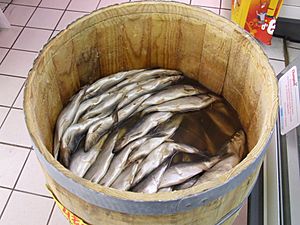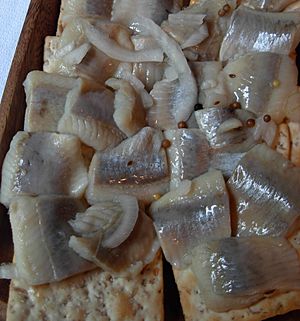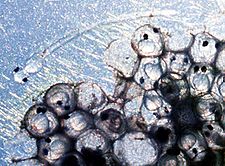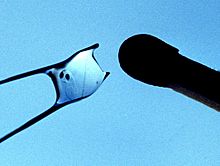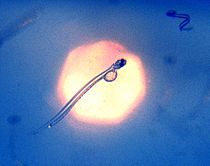Herring facts for kids
Quick facts for kids Herring |
|
|---|---|
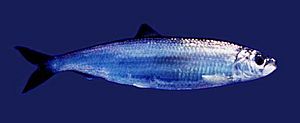 |
|
| Atlantic Herring | |
| Scientific classification | |
| Kingdom: | |
| Phylum: | |
| Superclass: | |
| Class: | |
| Order: | |
| Family: | |
| Genus: |
Clupea
Linnaeus, 1758
|
A herring is a small fish that lives in the ocean. It belongs to the genus Clupea. The most well-known type is the Atlantic Herring. There are about 15 different species of herring.
When herrings travel in the water, they usually swim in very large groups. These groups are called schools of herring. Like many other fish, they do this for safety. Swimming in big groups helps protect them from predators.
Herrings are often eaten by people. They can be smoked or pickled.
The phrase "red herring" is also used in stories. It describes a plot device in mystery books or movies. It's a clue that misleads the reader or viewer to a wrong solution.
Life Cycle of Herrings
Atlantic herring populations lay their eggs in different months of the year. Each group, or "stock," spawns at a special time and place. Some lay eggs in spring, others in summer, autumn, or winter.
Herrings in Greenland lay eggs in shallow water, about 0 to 5 meters (0 to 16 feet) deep. North Sea herrings lay eggs deeper, up to 200 meters (656 feet) down in autumn.
Female herrings lay their eggs on the sea floor. They choose places with rocks, stones, gravel, sand, or beds of algae. A female can lay between 20,000 and 40,000 eggs. On average, she lays about 30,000 eggs.
The eggs sink to the bottom. They stick together in layers or clumps to gravel, seaweed, or stones. This happens because of a sticky coating on the eggs.
If too many eggs are laid in thick layers, they might not get enough oxygen. This can cause them to die. The eggs need water movement, like waves or coastal currents. This movement helps bring oxygen to them. Eggs survive best in cracks and behind solid objects. This protects them from animals that eat eggs.
Each egg is tiny, about 1 to 1.4 millimeters (0.04 to 0.06 inches) wide. The size depends on the parent fish and the local type of herring. Eggs hatch in about 40 days at 3°C (37°F). They hatch faster in warmer water, like 11 days at 10°C (50°F). Eggs cannot survive in water hotter than 19°C (66°F).
When they hatch, herring larvae are 5 to 6 millimeters (0.2 to 0.24 inches) long. They have a small yolk sac that gives them food. This sac is gone by the time they are 10 millimeters (0.4 inches) long. Only their eyes are dark. The rest of their body is almost clear, making them hard to see in the water.
The dorsal fin (top fin) forms when the larva is 15 to 17 millimeters (0.6 to 0.67 inches) long. The anal fin (bottom fin) forms at about 30 millimeters (1.2 inches). The ventral fins (belly fins) appear, and the tail becomes forked at 30 to 35 millimeters (1.2 to 1.4 inches). When a larva is about 40 millimeters (1.6 inches) long, it starts to look like a small herring.
Young herring larvae are very thin. You can tell them apart from other young fish by where their vent (opening) is. It's very close to the base of their tail. It can be tricky to tell young herrings from sprats, which are similar fish.
At one year old, herrings are about 10 centimeters (4 inches) long. They start to lay their own eggs when they are three years old.
What Herrings Eat
Herrings play an important role in the ocean's food web. They eat tiny sea creatures called zooplankton. This includes copepods, arrow worms, pelagic amphipods, mysids, and krill. By eating zooplankton, herrings turn these small organisms into food for bigger animals.
Herring Fishing
Adult herrings are caught for their meat and eggs. They are also used as bait to catch other fish. Trading herrings is a big part of the economy for many countries. In Europe, herrings were once called the "silver of the sea." Their trade was so important that it's considered one of the most valuable fisheries in history.
The organization Environmental Defense has said that catching Atlantic Herring (Clupea harengus) is done in a way that is good for the environment.
Images for kids
-
Seabirds, like this European herring gull, hunt herring schools from above.
-
A kipper is a split and smoked herring.


